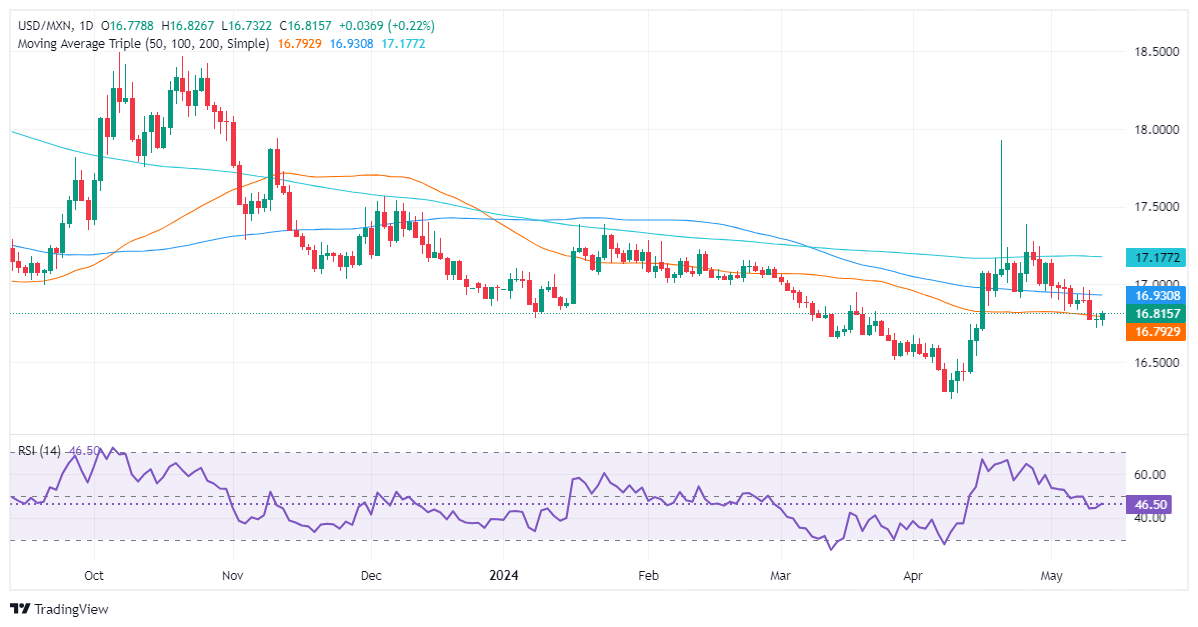- Mexican Peso drops 0.51% against USD after Banxico Governor suggests potential rate cuts.
- Governor Rodriguez Ceja notes core inflation's downtrend, fueling speculation of a June 27 rate cut.
- Attention turns to US inflation data, critical for upcoming Fed policy decisions.
The Mexican Peso depreciated versus the US Dollar during the North American session on Monday after Bank of Mexico (Banxico) Governor Victoria Rodriguez Ceja commented, “We could evaluate downward adjustments” to the main reference rate. In the meantime, traders brace for the release of the latest inflation figures in the United States (US), which would be the spotlight as the Federal Reserve (Fed) delineates its monetary policy path. The USD/MXN trades at 16.81, up 0.51%.
For the latest news on the Mexican Peso click here.
Banxico Governor Victoria Rodriguez Ceja noted that the increase in general inflation was due to volatile non-core components. Nevertheless, she added that core prices continued a “very clear” downtrend. She added that depending on the evolution of the inflationary outlook, the Mexican central bank could evaluate whether to continue lowering interest rates, starting with the next meeting on June 27.
Last week, Banxico decided to keep rates unchanged at 11.00% following March’s first rate cut. In its monetary policy statement, the Governing Council mentioned that inflationary shocks “are foreseen to take longer to dissipate,” which spurred an upward revision of inflationary figures.
Across the border, the US economic docket featured a speech by Fed Vice-Chair Philip Jefferson, who said that it’s appropriate to keep policy rates restrictive until inflation ebbs.
Daily digest market movers: Mexican Peso drops amid a light economic docket
- Mexico’s economic docket will be absent during the current week. The next economic data released would be Retail Sales expected on May 20, followed by the Gross Domestic Product (GDP) and inflation figures on May 23.
- Banxico will reveal its latest meeting minutes on May 23.
- April's data show that Mexico’s headline inflation is reaccelerating. However, core prices are falling. This spurred Banxico’s revision to its inflation projections, with the bank expected to hit its 3% target toward the last quarter of 2025, later than March’s estimates for Q2 2025. Core inflation is projected to hit 3% in Q2 2025.
- In the short term, the US economic docket will feature the Producer Price Index (PPI) on May 14, followed by the Consumer Price Index (CPI) and Retail Sales on May 15.
- USD/MXN traders are eyeing Fed Chair Jerome Powell’s on May 14.
- The deterioration in consumer sentiment, alongside a cooling labor market, has opened the door for investors to price in rate cuts by the Fed. This is because US central bank policymakers acknowledged that risks to achieving its dual mandate on employment and inflation “moved toward better balance over the past year.”
- Data from the futures market show odds for a quarter-percentage-point Fed rate cut in September at 79% versus 78% last Friday.
Technical analysis: Mexican Peso falls as USD/MXN rises above 16.80
The USD/MXN downtrend remains in play, but a daily close above last Friday’s high of 16.81 could form a ‘bullish engulfing’ candle pattern, which could pave the way for a leg up. In the near term, momentum favors sellers as the Relative Strength Index (RSI) remains bearish but is briskly turning bullish.
If buyers lift the exchange rate above the 100-day Simple Moving Average (SMA) at 16.92, that could exacerbate a rally toward the 17.00 psychological level. A breach of the latter would expose the 200-day SMA at 17.17, followed by the January 23 swing high of 17.38 and the year-to-date high of 17.92.
On the flip side, a bearish continuation could resume if the USD/MXN tumbles below the 50-day SMA at 16.78, opening the door to test the 2023 low of 16.62, followed by the current year-to-date low of 16.25.
Mexican Peso FAQs
The Mexican Peso (MXN) is the most traded currency among its Latin American peers. Its value is broadly determined by the performance of the Mexican economy, the country’s central bank’s policy, the amount of foreign investment in the country and even the levels of remittances sent by Mexicans who live abroad, particularly in the United States. Geopolitical trends can also move MXN: for example, the process of nearshoring – or the decision by some firms to relocate manufacturing capacity and supply chains closer to their home countries – is also seen as a catalyst for the Mexican currency as the country is considered a key manufacturing hub in the American continent. Another catalyst for MXN is Oil prices as Mexico is a key exporter of the commodity.
The main objective of Mexico’s central bank, also known as Banxico, is to maintain inflation at low and stable levels (at or close to its target of 3%, the midpoint in a tolerance band of between 2% and 4%). To this end, the bank sets an appropriate level of interest rates. When inflation is too high, Banxico will attempt to tame it by raising interest rates, making it more expensive for households and businesses to borrow money, thus cooling demand and the overall economy. Higher interest rates are generally positive for the Mexican Peso (MXN) as they lead to higher yields, making the country a more attractive place for investors. On the contrary, lower interest rates tend to weaken MXN.
Macroeconomic data releases are key to assess the state of the economy and can have an impact on the Mexican Peso (MXN) valuation. A strong Mexican economy, based on high economic growth, low unemployment and high confidence is good for MXN. Not only does it attract more foreign investment but it may encourage the Bank of Mexico (Banxico) to increase interest rates, particularly if this strength comes together with elevated inflation. However, if economic data is weak, MXN is likely to depreciate.
As an emerging-market currency, the Mexican Peso (MXN) tends to strive during risk-on periods, or when investors perceive that broader market risks are low and thus are eager to engage with investments that carry a higher risk. Conversely, MXN tends to weaken at times of market turbulence or economic uncertainty as investors tend to sell higher-risk assets and flee to the more-stable safe havens.
Information on these pages contains forward-looking statements that involve risks and uncertainties. Markets and instruments profiled on this page are for informational purposes only and should not in any way come across as a recommendation to buy or sell in these assets. You should do your own thorough research before making any investment decisions. FXStreet does not in any way guarantee that this information is free from mistakes, errors, or material misstatements. It also does not guarantee that this information is of a timely nature. Investing in Open Markets involves a great deal of risk, including the loss of all or a portion of your investment, as well as emotional distress. All risks, losses and costs associated with investing, including total loss of principal, are your responsibility. The views and opinions expressed in this article are those of the authors and do not necessarily reflect the official policy or position of FXStreet nor its advertisers. The author will not be held responsible for information that is found at the end of links posted on this page.
If not otherwise explicitly mentioned in the body of the article, at the time of writing, the author has no position in any stock mentioned in this article and no business relationship with any company mentioned. The author has not received compensation for writing this article, other than from FXStreet.
FXStreet and the author do not provide personalized recommendations. The author makes no representations as to the accuracy, completeness, or suitability of this information. FXStreet and the author will not be liable for any errors, omissions or any losses, injuries or damages arising from this information and its display or use. Errors and omissions excepted.
The author and FXStreet are not registered investment advisors and nothing in this article is intended to be investment advice.
Recommended content
Editors’ Picks

AUD/USD consolidates the rebound above 0.6450
AUD/USD clings to recovery gains above 0.6450 in the Asian session on Monday. A pause in the US Dollar uptrend supports the pair but the further rebound appears eluisive amid renewed geopolitical tensions between Russia and Ukraine. Fedspeak is next in focus.

USD/JPY regains 154.00 and beyond amid BoJ's Ueda-led volatility
USD/JPY has recaptured 154.00 in Asian trading on Monday after BoJ Governor Kazuo Ueda's comments injected volatility around the Japanese Yen. Ueda offered no clues on a likely December interest rate hike, weigihing heavily on the Yen while triggering a big USD/JPY jump.

Gold bounces off key support on renewed Russia-Ukraine geopolitical risks
Gold price (XAU/USD) extends its rebound to test $2,600 early Monday, snapping a six-day losing streak. The latest uptick in Gold price could be attributed to rsurfacing Russia-Ukraine geopolitical tensions after US authorizes Ukraine to use long-range US weapons to strike inside Russia.

Dollar rally 2024: Epic bull run or dangerous bubble?
Dear, The US dollar is surging—how high can it go? Is this unstoppable growth or a bubble about to burst? Discover the 5 key factors fueling this rally Watch, learn, and get ready for what’s next! .

Week ahead: Preliminary November PMIs to catch the market’s attention
With the dust from the US elections slowly settling down, the week is about to reach its end and we have a look at what next week’s calendar has in store for the markets. On the monetary front, a number of policymakers from various central banks are scheduled to speak.

Best Forex Brokers with Low Spreads
VERIFIED Low spreads are crucial for reducing trading costs. Explore top Forex brokers offering competitive spreads and high leverage. Compare options for EUR/USD, GBP/USD, USD/JPY, and Gold.
